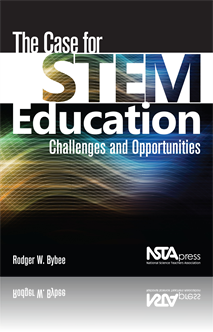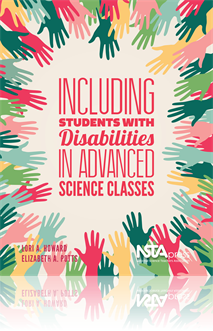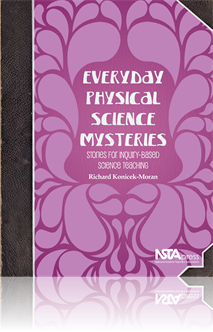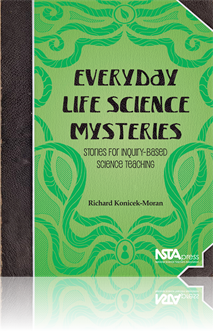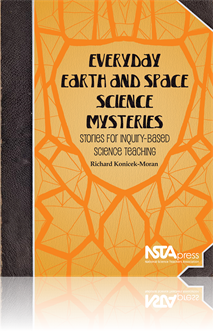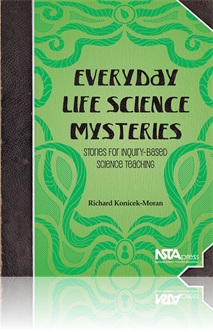All Book Chapters
Book Chapter
This overview covers the approach to the book, why this approach, and how this approach can fit into classroom routines. It also provides the best way to use the Teacher Edition and recommends reading the Before the Lesson, During the Lesson, and Aft...
Book Chapter
This chapter explicitly states how the book aligns with both the Next Generation Science Standards (NGSS) and the Common Core State Standards (CCSS), so that science educators can easily express to administrators, parents, students, and fellow collea...
Book Chapter
This chapter provides a list of supplies required for implementing all activities within this book. It is highly recommended that science educators purchase these supplies in advance to ensure that all materials are available for use....
Book Chapter
Teacher Guide for Earning Your White Coats: Medical School Research
In order to graduate medical school, all students must complete the research portion of this project. All medical students are required to investigate, as thoroughly as possible, the causes of, symptoms of, and potential treatments for four health c...
Book Chapter
Teacher Guide for What's Wrong With Me, Doc? Analyzing Medical Records
This chapter focuses on a residency program at Vanguard Hospital. The students analyze four patients’ medical records containing their symptoms, lifestyle habits, and family medical histories. Once the team has developed a hypothesis for each patie...
Book Chapter
Teacher Guide for Let's Diagnose Them, Lab 1: Urinalysis
In medical school, students learn about the excretory system and its urinary track. In this chapter, four patients have submitted urine samples. A urinalysis can determine the state of one’s health by examining physical and chemical properties of ...
Book Chapter
Teacher Guide for Let's Diagnose Them, Lab 2: Digestive By-Products and Body Mass Index Analysis
In this chapter, two of the four patients experience digestive issues. A team of doctors will run tests on the digestive by-products of these two patients, while the students will be expected to formulate an even deeper hypothesis about the condition...
Book Chapter
Teacher Guide for Let's Diagnose Them, Lab 4: HIV Test
In this chapter, based on blood samples recently analyzed, one of the four patients has a very low white blood cell (WBC) count. This is alarming since it might indicate the patient is suffering from a viral infection. Since all of the patients reque...
Book Chapter
Teacher Guide for Let's Diagnose Them, Lab 5: Lung Capacity
In this chapter, all four patients experience difficulty breathing. Students will determine the lung capacity of each patient using a spirometer, which requires the patient to exhale deeply in order to determine if diseases such as asthma, pneumonia,...
Book Chapter
Teacher Guide for Let's Diagnose Them, Lab 6: Hormone Test
The endocrine system produces hormones that help regulate the body’s internal organs. Hormones are chemical messengers sent through the bloodstream and when too little or too much is produced, it is often an indication that something is wrong. In t...
Book Chapter
Teacher Guide for Emergency! Lab 7: Performing Surgery
In this chapter, doctors are unsuccessful in reviving a patient who is an organ donor. The students are called upon to perform the donation surgery, with the job of identifying and removing various organs from the patient’s body. In the United Stat...
Book Chapter
Teacher Guide for The Ominous Phone Call and Evaluating the Docs
A diagnosis for each of the four patients has finally been developed. Before releasing them from the hospital, students must complete the medical charts and provide the pharmacist with the information under the sections “Diagnosis,” “Treatments...
Book Chapter
What Are the Challenges for STEM Education?
This chapter discusses contemporary challenges of STEM education. The chapter describes several challenges and presents a model introduced in earlier publications—the 4Ps of purpose, policy, programs, and practice—as a way to understand the vario...
Book Chapter
What Can We Learn From the Original Sputnik Moment?
This chapter reviews the Sputnik era—a significant turning point for the STEM disciplines—and reforms of the STEM disciplines. The chapter includes the historical discussion of the national mission and insights specific to educational reform beca...
Book Chapter
Is STEM Education a Response to This Generation's Sputnik Moment?
This chapter sets the stage for the remaining chapters by describing several unique features for the STEM reform. The chapter addresses the themes of globalization and current STEM-related issues, 21st century workforce skills, and the continuing pip...
Book Chapter
STEM Education Seems to Be the Answer—What Was the Question?
Here, the question seems to have been, “What do we need to develop a knowledge economy?” The answer is to focus on the STEM subjects—science, technology, engineering, and mathematics. This chapter directs attention to 35 reports and publicatio...
Book Chapter
If STEM Is an Opportunity, What Is the Federal Government's Role?
This chapter presents five policy recommendations for the Federal Government, and is a response to a federal mandate to review STEM initiatives across federal agencies and coordinate, if not consolidate, various programs. The chapter provides an oppo...
Book Chapter
How Can a State, District, or School Develop a Coherent Strategy for STEM Education?
This chapter presents a framework and concrete way to begin thinking about STEM programs and practices. The chapter identifies a general question about the purposes of STEM education and proposes answers to the question setting the stage for leaders ...
Book Chapter
What is Your Perspective of STEM Education?
This chapter presents different perspectives of STEM education. The goal is to clarify and not confuse the issue of STEM. These perspectives are based on many discussions, articles, reports, and projects where there is reference to STEM. The author h...
Book Chapter
STEM Education: Where Are You Now, and Where Do You Want to Go?
This chapter addresses a critical point—when taking a programmatic curricular view, does STEM imply an integrated perspective? This chapter begins with a view of separate STEM disciplines and progresses to a variety of ways that the STEM discipline...
Book Chapter
What Is Your Action Plan for STEM Education?
This chapter will help you develop an action plan by considering critical factors such as the unit of change, resources, components, and support for STEM education. The plan should address the way you initiate, implement, bring to scale, and sustain ...
Book Chapter
Classroom Considerations: Behavior
Behavior management is probably never an issue in your advanced-level science class, and you should not assume that it will be now that you have a student with a disability in your class. Remember that good preparation on your part will go a long way...
Book Chapter
Basic Special Education Terms and Laws
Science teachers are not responsible for knowing the intricacies of disabilities and disability laws, but the fact that students with disabilities will be in the classroom means that they need to have at least a working knowledge of disability termin...
Book Chapter
The science teacher is an important member of the IEP team—bringing unique knowledge and perspective—and communication with the rest of the team will lead to the best possible outcome for students with disabilities in advanced science classes. Th...
Book Chapter
Classroom Considerations: Instruction
This chapter focuses on the classroom. When students with disabilities are part of an advanced class, the content of the class will remain the same but the science teacher may need to make some slight adjustments to the instruction to ensure that all...
Book Chapter
Laboratory experiments are an essential component to the accelerated classroom and provide an interactive learning environment linking science concepts to “real world” observations. While the actual laboratory experiments or exercises will vary d...
Book Chapter
Assistive Technology and Your Classroom
Incorporation of technology into the advanced classroom has flourished as the national focus on success in STEM classes has accelerated. The assumption is that new technologies support student learning of scientific concepts and processes. Being rec...
Book Chapter
This chapter addresses requesting testing accommodations for students who need them from either the College Board or International Baccalaureate (IB). Planning is essential to success, so identifying which students will need to have testing accommod...
Book Chapter
One of the most important foundations for student success is the teacher. Particularly important is being open and willing to welcome students with disabilities into the classroom. The discussion in this chapter addresses concerns related to recruiti...
Book Chapter
The story in this chapter tries to set the stage for discussions and inquiry into the nature of temperature and heat and to the fact that heat exchange is the cause of what scientists call a phase change—when something goes from liquid to solid or ...
Book Chapter
In this chapter, this story really leaves us hanging! It’s a great one for real investigation! There are two purposes of the story: the first is to investigate closed systems. Anything that happens inside uses up only the materials in the jar, beca...
Book Chapter
The incident described in this story actually happened to the author during a camping trip in Everglades National Park years ago. The humidity was fierce but the air cooled down and overnight he awoke to a wet face and wet pillow. This story is des...
Book Chapter
This story is aimed at promoting not only inquiry into the germination of tree seeds but seeing trees as typical flowering plants, also known as angiosperms. There is also ample opportunity to take an excursion into fruits and seeds and the germinati...
Book Chapter
Trees From Helicopters, Continued
Maples are very interesting trees with lots of variation in form. They provide a view of diversity in plants as well as a chance to look at natural phenomena that is very common to anyone who has had a maple tree near them. The main purpose of this s...
Book Chapter
Flowers: More Than Just Pretty
Children love to look at flowers but few are inclined to become familiar with the structure and function of the flower. This story is aimed at providing some motivation for children to learn about one of the most important evolutionary developments i...
Book Chapter
Children as well as adults are usually intrigued by the ideas of bargains. More seeds for less money is often enough to convince them to buy a larger, cheaper package. In this case, the children are savvy enough to question the value of either packag...
Book Chapter
Children and adults alike are prone to believe that if a little of something is good, more is better. In the case of this story, your students will probably believe that if fertilizer is good for growing plants, it must be good for germinating seeds....
Book Chapter
Water makes up a very high percentage of all living things. This story is aimed at providing children with the opportunity to measure the surprising amount of water found in fruit. It also provides an opportunity for the teacher to emphasize the impo...
Book Chapter
What happens when seeds are soaked in water, you may find that your students cannot perceive of seeds absorbing so much water, for they may equate the seeds with how a sponge soaks up water. The story in this chapter offers students an opportunity to...
Book Chapter
Students are usually aware that seed plants have adapted to overcrowding by developing mechanisms that disperse their seeds to other locations. In this chapter, the story explores one of the important characteristics of plant evolution, the wide dist...




